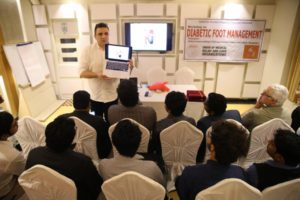Texas- Over 900,000 Rohingya refugees are living in unhealthy conditions in Cox’s Bazaar, Bangladesh. Due to a lack of available medical care, chronic diseases are ravaging the population. Among them, diabetes. This silent disease, whose severity is frequently underestimated, can cause multiple complications including the diabetic foot in 15% of cases. The onset of diabetic foot is the number one cause of amputation in the world according to a study conducted by the International Working Group on the Diabetic Foot. From January 28th to February 2nd, UOSSM doctors went to Cox’s Bazar on a humanitarian mission to train doctors on diabetic foot management.
Every 30 seconds, somewhere in the world, a patient’s foot is amputated because of diabetes.
A diabetic foot (ulceration of the foot), left untreated will inevitably lead to amputation. To prevent needless amputations, UOSSM organized a theoretical and practical training about the diabetic foot for local doctors and medical staff. The courses were taught by Dr. Dured Dardari, Associate Professor at La Sorbonne and Head of the Diabetic Podiatry Unit at the Sud-Francilien Hospital Center; Eric Deschamps, Orthopedic Technician and Marie Bouly, Therapeutic Education Nurse.
On the first day of the training mission, our doctors made an alarming observation to the question: “Do you make an evaluation of the podological risks to your diabetic patients?” 100% of the participants answered “no”.
“The training that we are offering to the camp doctors is vital because for people suffering from diabetes, taking care of a foot injury can save their life. The doctors of Cox’s Bazaar, originally generalists, are forced to become cardiologists, rheumatologists, diabetologists and even surgeons because of the lack of trained staff. If they are not trained, the patients suffer. The primary health centers are overcrowded and become micro-hospitals. ” Explains Dr. Dured Dardari.
The 16 trainee doctors (men and women) benefited from training on the basic pathophysiology of the diabetic foot; discharge arrangements (a technique to promote healing), local care, and antibiotic therapy. Three sessions were organized with practical applications, explanatory videos and case reports during day visits to the medical centers in the camps.
During these medical visits and after having set up a consultation room and organized a health post, the French doctors and their colleagues were able to examine numerous patients (complete podological examinations, a detachment of hyperkeratosis with scalpel, care and debridement of surgical wounds). More than one hundred patients were treated in the various camps in the region (Balukhali camp, Moynerguna camp).
“I have seen a population of refugees who are completely lost. They have lost hope, they no longer have a taste for life, the children do not smile anymore. They have left their village, their home, to which they will surely never return. It is overwhelming. ” Said Dr. Dured Dardari.
This first training mission for the management of the diabetic foot was a real success! Participants are now familiar with podiatric assessment and risk ranking methods for their diabetic patients. Each one of them was able to receive a certificate of completion of training. To follow up on the training, a telemedicine program was set up between UOSSM French doctors and doctors from refugee camps; as well as the delivery of medical equipment and footwear.








